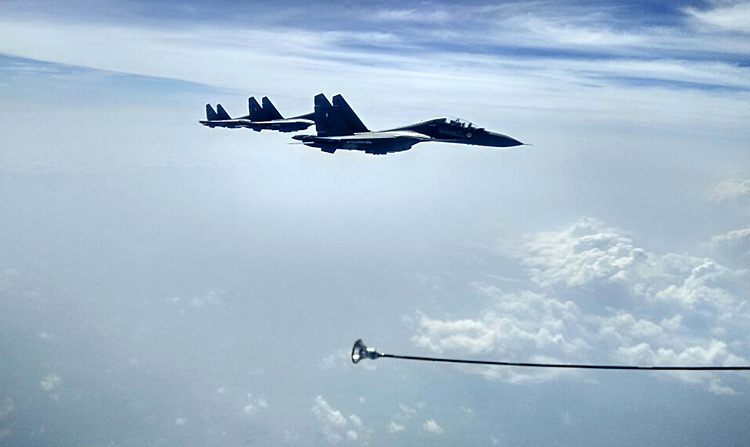INDIAN ARMED FORCES CHIEFS ON OUR RELENTLESS AND FOCUSED PUBLISHING EFFORTS

The insightful articles, inspiring narrations and analytical perspectives presented by the Editorial Team, establish an alluring connect with the reader. My compliments and best wishes to SP Guide Publications.

"Over the past 60 years, the growth of SP Guide Publications has mirrored the rising stature of Indian Navy. Its well-researched and informative magazines on Defence and Aerospace sector have served to shape an educated opinion of our military personnel, policy makers and the public alike. I wish SP's Publication team continued success, fair winds and following seas in all future endeavour!"

Since, its inception in 1964, SP Guide Publications has consistently demonstrated commitment to high-quality journalism in the aerospace and defence sectors, earning a well-deserved reputation as Asia's largest media house in this domain. I wish SP Guide Publications continued success in its pursuit of excellence.
"Gagan Shakti" Aerial Might on Display!
Exercise Gagan Shakti will also convey a message to Pakistan and China that any threat emanating from them, would be dealt with in a befitting manner

Exercise ‘Gagan Shakti’, translated into English to mean ‘Aerial Might’, that commenced on April 10, 2018, was a two-week long air exercise conducted by the Indian Air Force (IAF). The air exercise that had the involvement of the entire fleet of aircraft of the IAF based across the length and breadth of the country, has been described as the largest such effort undertaken by the service in the last 30 years.
The aims and objectives of the exercise were to test the operational preparedness and capability of the IAF to cope with the possible security challenges emanating from the two adversaries Pakistan and China that the nation may be confronted with. The assessment is to be made in terms of the state and performance of assets, professional capability of personnel manning these assets and the adequacy and competence of various supporting organisations. The purpose of the exercise was also to display to the nation, the combat preparedness of the force. Specifically, the exercise encompassed all aspects of aerial warfare including network-centric warfare, air defence, close air support, interdiction, deep strike, counter air operations, airborne assault operations, special heli-borne operations, aerial reconnaissance, medical evacuation and logistic support operations. In the worst case scenario, even with the shortages the combat fleet of the IAF is currently afflicted with, the organisation would have to be prepared to fight a two-front war. There is no other option available to the IAF.

One of the several objectives of the exercise was also to validate the capability of the IAF to dominate the entire extended area of the Indian Ocean Region. Su-30 MKI air superiority combat aircraft of the IAF armed with the potent BrahMos supersonic cruise missile, a combination cleared recently and the fleet of Jaguar deep penetration strike aircraft armed with the Harpoon anti-ship missiles, displayed their strategic reach and capability to carry out operations over the maritime zone in coordination with the Indian Navy. The critical role that a flight refuelling aircraft can play in the enhancement of reach and capability of the combat fleet of the IAF over the Indian Ocean region extending to the island territories, was also clearly demonstrated. This is particularly relevant in the context of the perpetually increasing level of activity by the People’s Liberation Army Navy (PLAN) of China in the Indian Ocean which could pose a serious threat to the sea lanes of communications on which the Indian economy is heavily dependent. For a realistic appraisal of capability, the various types of aircraft participating were required to operate both by day and night.
Exercise Gagan Shakti was conducted in two phases. Phase I consisted of operations along the India-Pakistan border. Phase II, involved operations along the India-China border and included aircraft operating from airfields located at high altitudes that have been made operational and capable of handling both combat aircraft and large transport aircraft of the IAF. As divulged by the IAF, about 1,100 aircraft including fighters, transport and helicopters as also drones participated in Exercise Gagan Shakti. Given the fact that the combat fleet of the IAF has dwindled to 31 squadrons, the total number of combat aircraft the IAF has would be in the region of 620. Of this number, with the flight line availability at 80 per cent as stated by Air Chief Marshal B.S. Dhanoa, Chief of the Air Staff during a media briefing, the number of combat aircraft actually participating in the exercise was around 560. The remaining aircraft participating in the exercise were from the transport and helicopter fleets as also force multipliers.
Exercise Gagan Shakti will help the IAF make an accurate assessment of the state of operational preparedness across the spectrum of capability
During the exercise, over 11,000 missions were flown and in all, more than 15,000 air warriors participated in the exercise. In addition, for segments of the exercise involving joint operations with the Indian Army and the Indian Navy, personnel of these two services were also involved. One notable feature of the exercise was that the light combat aircraft Tejas Mk I that has been inducted into the IAF in the recent past and has generally been used as a technology demonstrator, participated for the first time in an air exercise where the indigenously produced platform had the opportunity to display its operational capability, firing close combat and beyond visual range (BVR) missiles. This should inspire the Indian aerospace industry to aim for further achievements and to cross new milestones in the regime of indigenous production of aircraft, particularly of combat platforms.
While Exercise Gagan Shakti will undoubtedly help the IAF make an accurate assessment of the state of operational preparedness across the spectrum of capability, it will also convey a message to Pakistan and China that any threat emanating from them, would be met with in a befitting manner.





